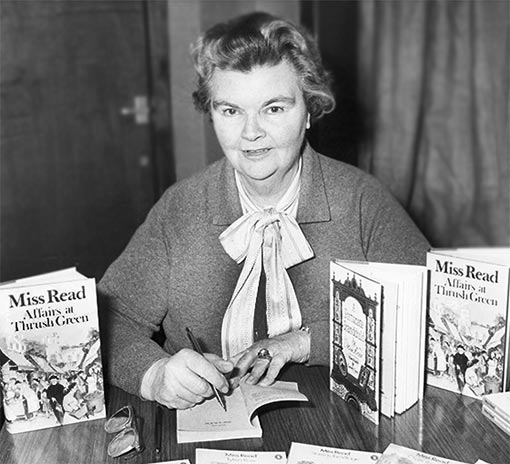The Novels of Miss Read
by Dora Saint
A friend of mine has a favorite book series, The #1 Ladies’ Detective Agency by Alexander McCall Smith, which, she assures me, significantly lowers her blood pressure when she reads them. When I want to flee the push-and-shove of what Os Guinness calls “advanced modernity,” I seek out a series of novels about an unmarried schoolmistress who heads a school located in the imaginary village of Fairacre, England. The schoolmistress’s name is Miss Read, and she is the narrator/writer of the Fairacre series. The world Miss Read creates in her books can, in a single page, turn my thoughts away from today’s fast-paced digital dramas and usher in quieter, slower times in the English countryside of the recent past.
Book series are immensely popular with readers and there are some good reasons for this – one is the ease with which one can re-enter a familiar setting that is associated with the series’ storyline; another is the fun of meeting a favorite character again, an individual whose quirks and foibles are well known to us.
As far as reviewing a series, there are plenty of great series from which to chose, but I would like to share with you the Fairacre series by Miss Read (April 17, 1913 to April 7, 2012).
Miss Read, the name under which all of the Fairacre, and a second series of books called Thrush Green, are written, is the pen name of Dora Jessie Saint. Saint was born in London in 1913, but her family moved to the country soon after for the sake of her mother’s health.[1] After teacher training at Homerton College, Cambridge, Saint became an educator, and taught for seven years prior to her marriage.[2] She and her husband, Douglas had one daughter, Jill.[3] It was after the birth of her daughter that Saint began her Fairacre books.
Historically, the Fairacre series takes place in the years following World War II. The quiet ways of the little country village obviously appealed to the people of war weary Britain as all of Miss Read’s books sold widely, and several of them are still in print[4]
The first of Saint’s books, Village School, was published in 1955 (Houghton Mifflin).The final book written by Miss Read, A Peaceful Retirement, was published in 1996.
In Village School we are introduced to Miss Read and her students, as well as Miss Clare, Miss Read’s elderly co-worker. Other characters include the kindly Reverend Gerald Partridge, vicar of the parish with which the school is associated, and the redoubtable Mrs. Pringle, school-cleaner extraordinaire and thorn in the flesh of Miss Read. All of these characters, and many more, appear regularly in the twenty books about everyday life in the school, church and village of Fairacre. The setting is pastoral, but not everything is peaceful and calm in Fairacre. Miss Read’s stories include the reality of violence in the home, lack of available work and the struggles of educating children in a poor, rural location.
The Fairacre series is notable in that the voices of all the main characters are written in the first person. This makes the reader the confidante of several individuals in the series as we learn of their joys, fears, habits and prejudices through their thoughts. The use of the first person voice may be why these personalities make such a strong impression on the reader and why it is easy to feel as though we truly know them.
In the following excerpt from Village School, Miss Read is standing in the nave of ancient St Patrick’s church overseeing her students’ involvement in decorating the altar for the annual Harvest Festival when a feeling of comfort overtakes her:
“The troubles and vexations of the last twenty-four hours suddenly seemed less oppressive. It is difficult, I reflected, to take an exaggerated view of any personal upheaval when standing in the building that has witnessed the joys, the hopes, the griefs and all the spiritual tremors of mortal man for centuries… In the presence of this ancient, silent witness, it was right that personal tears should assume their own insignificant proportions. They were, after all, as ephemeral as the butterflies that hovered over the Michaelmas daisies on the graves outside…”
In a later chapter of Village School, Miss Read has gathered her students to listen to a story:
“Together, the children and I set out into that enchanted world where the river laps eternally and the green banks form the changeless setting for Mole’s adventures. The sun dappled the children’s heads as it shone through the tossing boughs into the schoolroom. Around them lay the sunshine, and within them too, as they contemplated, with their mind’s eye, the sunlit landscape conjured up by magic words.”
The story of Village School proceeds through the school year with chapters such as, “Getting Ready for Christmas,” “April Birthday Party,” and “End of Term.” It all appears ordinary, but as Frederick Buechner has said, “The sacred moments, the moments of miracle, are often the everyday moments.” Dora Saint, or Miss Read, as I think of her, has indeed captured “moments of miracle” in her series.
If you are weary of the bombardment that accompanies “advanced modernity,” escape to the English countryside for a bit with a book from Miss Read – you might find a quiet miracle waiting there for you.
[1] “Obituary: Dora Saint” Daily Telegraph April 11, 2012
[2] Ibid
[3] Ibid
[4] Ibid


Long before I became a teacher, I enjoyed the quiet respites from my high tech job that Miss Read provided. When I became a teacher, I appreciated her wisdom, humor and compassion even more. And now that I am a retired teacher, I look forward to many a companionable sun dappled afternoon spent in Fairacre with very good company.